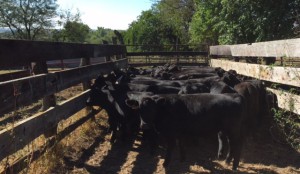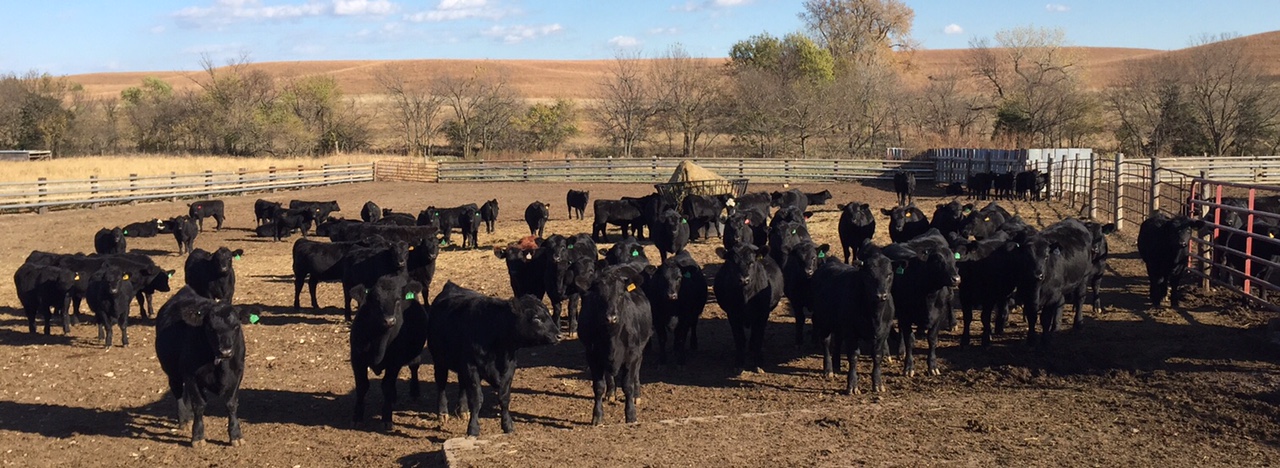That could be a fraction, but it means in 11 years out of 13, a 1993 CattleFax report said you could have made money retaining ownership of home-raised calves through the finishing phase and selling to a packer.
Yes, I know, that was a long time ago – seems like only yesterday though. I got started in the cattle business in the early 1980s, when only a few pioneers tried to improve herd genetics based on how their calves finished. Fewer still had any idea how they graded. I was more clueless than most.
Economists and market analysts were trying to assess the risk/reward for this and related options because astute cattlemen, unlike me, were trying to learn about their calves by feeding them. Of course, they hoped to make money, too.
 An average weaning weight in the 1980s was 475 pounds (mine shown at right beat that by nearly 100 pounds in mid-September 2015), so that’s the weight entered into the CattleFax model that showed the best year returning $213 per head and the worst losing $32 for an average profit of $67/head from 1980 through 1992.
An average weaning weight in the 1980s was 475 pounds (mine shown at right beat that by nearly 100 pounds in mid-September 2015), so that’s the weight entered into the CattleFax model that showed the best year returning $213 per head and the worst losing $32 for an average profit of $67/head from 1980 through 1992.
An earlier North Dakota study showed that it paid to retain ownership by backgrounding and then finishing home-raised calves EVERY year from 1958 through 1974. That string was only broken by the political turmoil of embargo and price freezing, but the charm was broken and only 4 of the next 10 years showed a profit in that retained ownership strategy.
OK, this was really a long time ago: in those days we looked at calves only as commodities, and the only plan for feeding was trying to reach a profitable finished weight of perhaps 1,000 pounds (on the hoof, not carcass weight as today).
A few weeks ago I was rummaging around online, trying to find an update to that “11 out of 13” or about 85% profit likelihood study, but now realize too much has changed to make such analysis worth doing. A 2005 summary from Iowa State University still provides useful discussion however.
More cow-calf producers retain ownership these days (including those who share ownership with a feedlot), but virtually none of us consider our calves a commodity. Many began feeding in the late 1990s – me in 2000 – as a way to learn more about our herds, and to use that information to improve.
 Maybe I should not have sold on a grid that first year, because discounts cost me about $100 per head when the cattle could have at least broke even on the cash market. But I wanted individual data so much, I reasoned that loss was going to be tuition in this school.
Maybe I should not have sold on a grid that first year, because discounts cost me about $100 per head when the cattle could have at least broke even on the cash market. But I wanted individual data so much, I reasoned that loss was going to be tuition in this school.
The harvest sheet, my first report card, said 10% had qualified for the Certified Angus Beef® (CAB) brand, whose team I had joined a couple of years earlier. The national average was 18%, so I had far to go. Worse, another 10% were Standard grade, which is lower than Select. One of those was a Yield Grade 4.
I knew some cooperators in sire evaluation programs with the American Angus Association were already getting 60% CAB, and many of those guys said they had signed up for that program to get the data and improve.
If I tracked numbers as much as I track words, I could tell you exactly how many years I made money retaining ownership, which I have done 14 out of 15 years. I know I made my cattle better and better by culling from the bottom and using A.I. on the rest.
All I can say for sure is that first year and last year stand out as two that fell noticeably short of breaking even, and at least two other years made noticeably large profits per head. I figure I am slightly ahead on dollars, before I get to the added value in my herd, with three years of harvest sheets showing better than 70% CAB and a few Primes.
Retaining ownership opens your eyes and new doors to herd improvement. That’s why my steers are headed off to my feedlot partner again next week.
Let’s keep building tomorrow together,
Steve
PS—We’re on a month-long quest called, “Every number has a story.” Follow along—it’ll be fun.
PS-Have you been following along this month? “Every number has a story,” and we’re telling them all right here:
Day one: $6.93
Day two: 2.5 million
Day three: $204.10
Day four: 12.1 million
Day five: 11/13
Day six: 8 million
Day seven: 139
Day eight: $39
Day nine: 30.1%
Day 10: 120 million
Day 11: -2.26
Day 12: 12 to 15 minutes
Day 13: 30%
Day 14: 32 million
Day 15: $154,000
Day 16: 118
Day 17: .51
Day 18: 105
Day 19: 1650
Day 20: 36,575
Day 21: 603
Day 22: 23%
